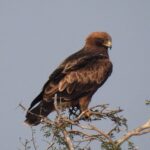The booted eagle (Hieraaetus pennatus) is a medium-sized, mostly migratory bird of prey known for its impressive speed and agility. With a wingspan of 110-132 cm and a length of 40 cm, this raptor is a formidable hunter, capable of reaching impressive speeds during its characteristic hunting stoop.
The Booted Eagle’s Top Speed
The booted eagle is capable of reaching speeds of up to 200 km/h (124 mph) during its high-speed dive, known as a hunting stoop. This makes it one of the fastest birds of prey, though not quite as fast as the peregrine falcon, which can reach speeds of over 322 km/h (200 mph) during its hunting dive.
| Bird of Prey | Top Speed (km/h) |
|---|---|
| Peregrine Falcon | 322+ |
| Booted Eagle | 200 |
| Golden Eagle | 190 |
| Gyrfalcon | 180 |
Despite its impressive speed, the booted eagle’s top speed is still lower than that of the peregrine falcon, which is considered the fastest animal on the planet during its hunting dive.
Hunting Strategies and Prey
 Image source: Booted eagle By Dr. Raju Kasambe
Image source: Booted eagle By Dr. Raju Kasambe
The booted eagle’s speed and agility make it a formidable hunter, capable of pursuing a variety of small prey. Its diet consists primarily of small mammals, reptiles, and birds, which it typically hunts by soaring and then diving at high speeds to catch its target.
One of the booted eagle’s unique hunting strategies is its ability to hover and scan the ground for potential prey. This allows the bird to conserve energy and strike quickly when it spots a suitable target.
Habitat and Breeding Behavior
The booted eagle is found in a wide range across the Palearctic and southern Asia, with breeding populations in Western Europe, Eastern Europe, and parts of Asia. These birds prefer a habitat that includes a mix of woodlands and open areas, often near marshlands and stone pine trees.
Booted eagles typically breed in pairs, building nests out of sticks and lining them with leaves or conifer needles. The female incubates the 1-2 eggs for around 45 days, and the chick fledges after 70-75 days.
Conservation Status and Threats
The booted eagle is considered a “rare” bird in Europe, with breeding populations in countries like France, Portugal, Spain, Russia, Turkey, and Ukraine. In Italy, the booted eagle is a regular migrant, but its wintering status is more irregular.
One of the main threats to the booted eagle is habitat loss, as the conversion of its preferred mixed woodland and open habitats to more intensive agricultural or urban land use can negatively impact its populations. Additionally, the booted eagle may face threats from hunting, poisoning, and collisions with power lines or wind turbines.
Conclusion
The booted eagle is a remarkable bird of prey, known for its impressive speed and agility during its hunting stoop. With a top speed of 200 km/h (124 mph), this raptor is one of the fastest birds in the sky, though it still falls short of the peregrine falcon’s record-breaking speeds.
The booted eagle’s unique hunting strategies, habitat preferences, and breeding behavior make it a fascinating subject for birdwatchers and researchers alike. As a “rare” bird in Europe, the booted eagle’s conservation status is an important consideration, and efforts to protect its habitat and mitigate threats are crucial for the long-term survival of this remarkable species.

